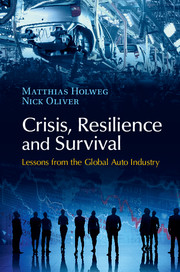Book contents
- Frontmatter
- Dedication
- Contents
- List of figures
- List of tables
- Acknowledgements
- 1 Why a book on corporate resilience?
- 2 The evolution of a global industry
- 3 Competing in a global industry
- 4 Concepts: Stakeholders, operations and context
- 5 Rover: Inside a failing car company
- 6 The failure of Saab Automobile
- 7 Near misses: Chrysler and Nissan
- 8 The future shape of the industry
- Appendix
- Notes
- Bibliography
- Secondary data sources
- Index
8 - The future shape of the industry
Published online by Cambridge University Press: 05 December 2015
- Frontmatter
- Dedication
- Contents
- List of figures
- List of tables
- Acknowledgements
- 1 Why a book on corporate resilience?
- 2 The evolution of a global industry
- 3 Competing in a global industry
- 4 Concepts: Stakeholders, operations and context
- 5 Rover: Inside a failing car company
- 6 The failure of Saab Automobile
- 7 Near misses: Chrysler and Nissan
- 8 The future shape of the industry
- Appendix
- Notes
- Bibliography
- Secondary data sources
- Index
Summary
In this chapter we revisit our key findings and lay out the implications of these for understanding crisis, resilience and survival in the auto industry. We shall first look at what our cases show about how auto firms get into crisis, and then how they get out of a crisis – or fail to do so. We then present a ‘resilience index’ that – by drawing on information from a variety of publicly available sources – quantifies the likely resilience and the strategic vulnerabilities of the world's major car companies. We then look at the implications of a major disruption in the industry – such as a significant shift towards alternative powertrains – for the resilience of existing auto companies.
WHY DO AUTO FIRMS GET INTO CRISIS?
Our argument thus far has been that many analyses of the auto industry, implicitly or explicitly, assume that resilience, failure and survival can be explained by the capability of car companies to design, make and sell cars to competitive standards. This view is persuasive and is based on a Darwinian notion of survival-of-the-fittest. We accept that such capabilities are significant, but of themselves they only go so far in explaining the current shape of the auto industry, and are limited in their ability to predict the future shape of the industry. To provide a more comprehensive picture, we must invoke a number of additional factors (explained in full in Chapter 4) if we are to understand the survival prospects of an auto firm.
The first is the industry characteristic of overcapacity. The economic, social and symbolic importance of car manufacturing means that there are strong incentives to establish car manufacturing operations and even stronger obstacles to closing them, over and above the market forces of supply and demand. Thus nations whose markets are large enough may use market access as a bargaining counter in order to pressure global car makers to manufacture locally and to force technology transfer with nascent local firms, as China has been doing since the mid 1980s. On the other hand, try as they might, not all governments can overcome global economic conditions and ‘force’ the development of a local car industry.
- Type
- Chapter
- Information
- Crisis, Resilience and SurvivalLessons from the Global Auto Industry, pp. 259 - 290Publisher: Cambridge University PressPrint publication year: 2015



